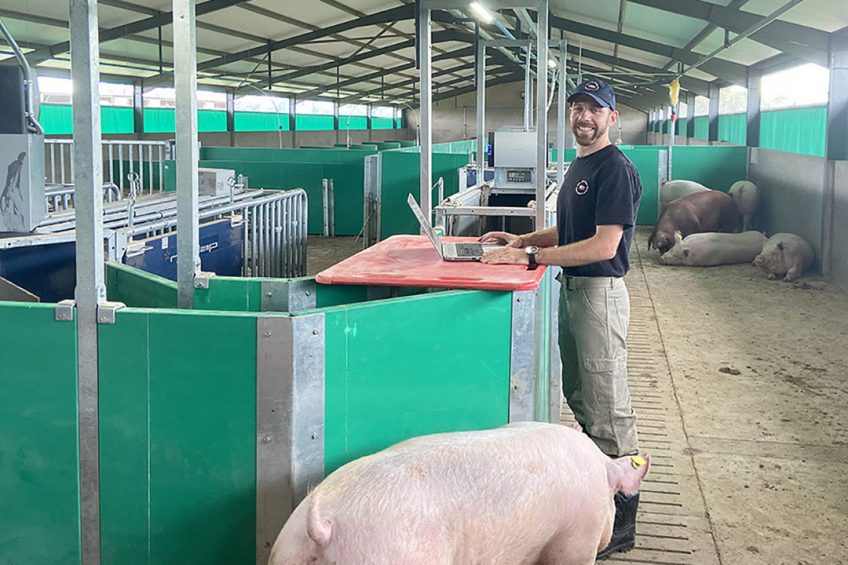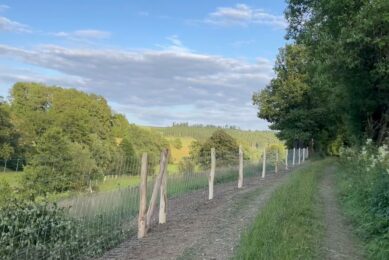Farm visit South Africa: Staying positive in times of challenges

Battling power cuts and poor national pork consumption rates are just two of the challenges South African pig farmer CP Kriek faces each week on his farm. However, maximising efficiency by investing in new technology and modernising ageing pig housing is helping Kriek control his costs in the constant fight for profit.
By African standards, Taaibosch Piggery, part of the Taaibosch Group, is quite a large operation. Kriek is the managing director of the group, of which he and his family – wife Gerda and 3 children – are shareholders.
The sprawling piggery is located in Fochville, situated on the border of Gauteng and North West provinces, about 100km west of Johannesburg. It is a fairly standard farrow-to-finish pig unit with 2,200 breeding sows. Additionally, there is a genetic nucleus with capacity for 250 sows. There is also an on-farm gene transfer centre for both the nucleus and commercial herds.

Producing late-maturing finisher pigs
Kriek’s goal is to produce a late-maturing finisher pig which is a top quality animal that attracts a decent market value. “We put a lot of focus and value on a good effective finishing pig and pride ourselves on a late-maturing finisher,” says Kriek. “Gilts are mated at about 33 weeks of age as we prefer them to be slightly more mature at the time of mating. We carry out 100% AI on all sows, except for the odd one that comes into heat at a strange time, and we have our own on-site AI station.

“We start marketing from 20 weeks, after we individually weigh and record pigs at 19 weeks,” says Kriek. “We don’t castrate boars, and all the males are marketed before 22 weeks. The females are marketed up to 24 weeks old. Our aim is to market an 83–85kg carcass or around 110kg live weight. All our pigs are sold to accredited processors or abattoirs in the Gauteng province. Because we weigh and market individually, we direct them to the most desired market. Currently our heavies, those with a carcass over 80kg, are sold for 22.75 rand/kg (€ 1.10) and the baconers, around 70kg carcass, are sold for 24.00 rand/kg (€ 1.16),” he says.
Variety of breeds
Taaibosch Piggery uses a variety of breeds in the herd to improve the productive traits of the offspring, including the popular names and some homemade ones. Kriek says: “We use Large White and Landrace as an F1 commercial cross as this is a good combination of maternal and terminal traits, with good reproductive performance and good terminal potential. We also use a combination of terminal lines, including Duroc for growth rate, marbling and quality and Pietrain for muscling and carcass yield.”

He adds, “There is also the Taaibosch homebred composite to combine farm-specific traits which have proved economically valuable over the years, mixing Large White, Pietrain and Duroc.”
On-farm feedmill
Taaibosch boasts its own on-farm feedmill, which is quite handy as it is located in the main maize production area of South Africa and is close to the food processing capital. “Pigs are fed a mostly grain-based diet consisting mainly of maize, soybean meal and wheat bran,” says Kriek. “We have our own on-farm feedmill where we mix specifically formulated rations and produce about 1,100 to 1,200 tonnes of feed per month. Custom-prepared premix macro packs and other feed additives are bought in. Our farm extends to 400 hectares on which we have the piggery and land for hay production. The remainder is leased to a neighbour for beef production.
“We don’t grow any feed raw materials ourselves but have an agreement with neighbours who produce maize to deliver directly to our feedmill. On our own farm some grass crops are planted, which are fertilised with pig slurry and then harvested to be sold as animal feed. A small portion is used in group housing as enrichment and feed supplement,” he says.

Housing conditions
Good housing conditions are vital to a healthy herd as summer temperatures in this part of South Africa can climb to over 34˚C but cool down at night to 16–18˚C. The winter day temperatures are around 18–26˚C, but can fall dramatically at night to -7˚C in August.
“We use good insulation on roofs, automated curtains to maintain good natural airflow and often install chimneys,” says Kriek. “On the more sensitive buildings we include evaporative cooling and mechanical ventilation.”

He continues: “In my opinion a 75–100mm insulated roof with big ventilation windows and enough tree and grass cover is a very economical way of maintaining temperatures. Having sufficient water drinkers, nipples and an ample supply of water at the right pressure and temperature is non-negotiable in our climate.”
Advancements in technology
Kriek is always monitoring advancements in technology and gauging if any would help increase the efficiency of his farm; he has some improvements in the pipeline. He says: “We are consistently exploring, investigating and investing. Currently we are in the process of moving towards converting old sites to Electronic Sow Feeding systems. I focus a lot on the use and integration of data on a central platform to facilitate the huge amount of data which is continuously generated. This includes the production software we use, slaughter data, feedmill records, as well as ventilation and environmental data.

“Since we do individual numbering of animals from birth, we offer lifetime traceability. However, to maintain and administer that, I rely heavily on technology and innovative solutions to streamline the process.”
Labour availability
South Africa has a whopping unemployment rate of around 30% which, experts say, could increase to 50% during the coronavirus pandemic. Farm workers are in plentiful supply but farmers say it is difficult to find those who possess the necessary skills. However, Kriek offers good educational initiatives to help him find suitable staff.
“Across all activities we employ 110 people including management and support operations, as well as on job-sharing initiatives,” Kriek says. “All our employees are local or from nearby tertiary institutions and we continuously partner with these institutions to offer practical training and internships. We made a decision to focus employment on local youth and established a training centre to upskill workers and offer training programmes for staff children and community youth on various aspects of agriculture. Management live on-farm and our labour force live in town for which we supply daily staff transport and other support programmes,” he says.

ASF in South Africa
Although African Swine Fever (ASF) is spreading fast in other areas of South Africa, it is not so common in the area around Taaibosch Piggery. Kriek says, “We don’t have any cases of ASF in our region, but further north we have ASF endemic to the wild warthog population. In 2019 we had a few outbreaks of ASF in informal piggeries, which were quickly contained and eradicated. Since we are used to farming in a country which has ASF- and [Foot-and-Mouth Disease] FMD-positive areas, we established the Registered Pig Compartment system which is managed and administrated by [Department of Agriculture, Forestry and Fisheries] DAFF.”

Farm visits
With an interactive map Pig Progress takes you around the world one pig production farm at a time.
He continues: “Each registered piggery operates as a quarantine unit with strict biosecurity and access control. This ensures the prevention of any uncontrolled access and movement into our piggeries, and the screening of workers and vehicles is regularly carried out.
“We follow strict control measures with feed and raw materials and all fences are pig and scavenger proof and maintain at least two barriers, one of which will prevent nose to nose contact between livestock and any outside contact. We even have a washing and disinfection station at our farm entrance located one kilometre before the piggery. All compartments are also serologically screened twice a year for ASF, [Classical Swine Fever] CSF, FMD and [Porcine Reproductive and Respiratory Syndrome] PRRS,” he concludes.
Main challenges
There are a number of challenges facing pig farmers in South Africa besides disease risk, with low national pork consumption being just one of them. The current Covid-19 pandemic isn’t helping much either. “Sadly, we have a very low per capita consumption of pork in world terms,” Kriek explains. “The total lies somewhere between 4.6kg and 4.9kg per person per year.
“This is further complicated by a strong misperception of pork and religious or cultural resistance to pork. This is a limiting factor to increase local consumption and we are struggling to gain access to large international markets, although we produce world class pork in very well-designed and well-operated piggeries.
Because we have a very healthy national herd in terms of controlled diseases, the importation of new genetic material is very strict and difficult which makes it challenging to get easy access to the latest genetic developments.
Since we are dependent on imports for a variety of raw materials, inputs and equipment, we are exposed to an additional level of uncertainty
The national infrastructure is ageing, and we often struggle with electricity supply, due to load shedding, and access to good and stable telecommunications and internet networks. For that reason we have standby generators on all our production sites.
Another challenge is that our currency is weak and volatile. Since we are dependent on imports for a variety of raw materials, inputs and equipment, we are exposed to an additional level of uncertainty.”
Supportive of Covid-19 lockdown
“As a producer of essential products in the South African food supply chain, we can continue operating during this virus pandemic, but it is more difficult to get our work done because of the national lockdown. We are supportive of the lockdown and have made early preparations to continue. We had to move to a skeleton staff of 30 people who we could comfortably accommodate on-farm and still provide food and entertainment for in our brand new training centre.

Country focus
1 country at the time… Pig Progress looks into production and consumption, exports and imports, even challenges and opportunities.
The biggest effect is market related. Our pig prices have started to come down as there are fears of continuous demand and processing capacity between farmer and consumer. Our biggest impact, however, is from the world markets in raw materials. We have seen major increases on all major inputs and raw materials. Also, commodities not being hedged in advance is problematic,” he adds.











